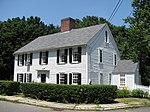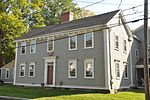Merrifield House
Essex County, Massachusetts Registered Historic Place stubsFederal architecture in MassachusettsHouses completed in 1792Houses in Ipswich, MassachusettsHouses on the National Register of Historic Places in Essex County, Massachusetts ... and 1 more
National Register of Historic Places in Ipswich, Massachusetts

The Merrifield House, also known as Rosebank, is a historic house at 11 Woods Lane in Ipswich, Massachusetts. It was built c. 1792 by Francis Merrifield, Jr., a veteran of the American Revolutionary War. The main block of the house is a 2.5 story, nearly square, wood-frame structure with an off-center chimney. The house has a number of rambling additions, some of which may have been built by Merrifield to accommodate his large family. It is also somewhat unusual in having a second cooking fireplace in its second level.The house was listed on the National Register of Historic Places in 1980.
Excerpt from the Wikipedia article Merrifield House (License: CC BY-SA 3.0, Authors, Images).Merrifield House
Woods Lane,
Geographical coordinates (GPS) Address External links Nearby Places Show on map
Geographical coordinates (GPS)
| Latitude | Longitude |
|---|---|
| N 42.6775 ° | E -70.830861111111 ° |
Address
Woods Lane 11
01938
Massachusetts, United States
Open on Google Maps










